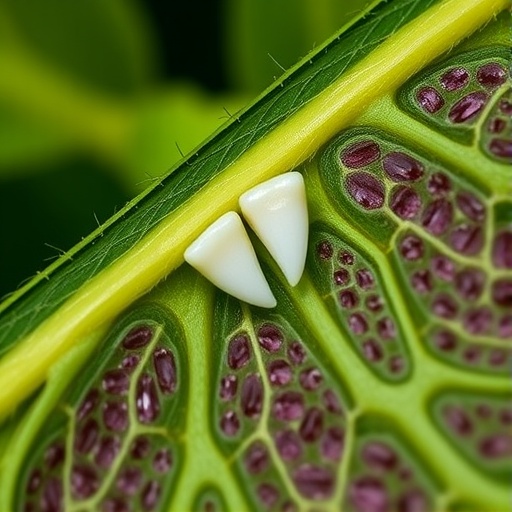The intricate world of Botany is continuously revealing surprising findings that challenge our traditional understanding of plant functions. A recent study meticulously conducted by researchers V.C. Dalvi, D.I. Rocha, and J. de Paula-Souza delves into the enigmatic multifunctionality of leaf teeth, specifically within the Violaceae family. This examination goes far beyond the conventional perspective of leaf structures, highlighting how these outward projections serve pivotal roles in the plant’s survival and ecological interaction.
Leaf teeth have long been viewed primarily as structural features influencing the aesthetic appearance of leaves or playing a straightforward role in the process of photosynthesis. However, the recent investigation presents a more nuanced understanding showcasing that these serrated edges are far more complex. The study reveals that leaf teeth also contribute to physiological processes such as light capture efficiency, water retention, and herbivore deterrence.
The research conducted by the authors centers on a variety of species from the Violaceae family, scrutinizing them through a multi-faceted lens. By employing analytical methods such as leaf morphology analysis and physiological assessments, the authors have succeeded in providing a comprehensive view of how leaf teeth facilitate essential adaptive strategies. This exploration integrates questions of evolutionary biology, ecology, and plant physiology, demonstrating how these teeth have evolved distinct functionalities balancing various environmental pressures.
Perhaps one of the most striking findings of the research is the revelation that leaf teeth can significantly enhance a plant’s efficiency in harnessing sunlight. Leaf teeth modify the leaf’s overall morphology, allowing it to capture more light across different angles throughout the day. This structural adaptation proves essential in environments where light can be variable, ensuring that these plants maintain adequate photosynthetic rates for optimal growth.
Water retention, another critical aspect of plant health and growth, is also markedly affected by the presence of leaf teeth. The study reveals that these serrations can alter the microclimate around the leaf surface by creating pockets of moisture that minimize transpirational water loss. This adaptation may confer critical survival advantages in arid environments where water scarcity is a persistent challenge.
Moreover, leaf teeth have also been shown to play a role in defense mechanisms against herbivores. The serrated leaf edges can deter insects and larger herbivores alike, serving as a physical barrier that complicates their feeding behavior. This defensive attribute is vital for the survival of plants in competitive ecosystems, where herbivory can severely disrupt growth and reproduction.
Beyond these physiological functions, the research casts light on the ecological interactions shaped by leaf teeth. For example, specific leaf morphology can influence the preferences of pollinators and seed dispersers, thereby altering plant reproductive success. The interconnections among morphological traits, animal interactions, and environmental factors are thus intricately woven, illustrating the complex tapestry of plant life.
This pioneering work sets the stage for future research avenues exploring other plant families and their distinctive leaf structures. This broader understanding could facilitate advancements in agriculture and conservation biology, where knowledge of plant adaptations can directly translate into better management strategies for crops and endangered species alike.
Additionally, researchers emphasize the importance of interdisciplinary approaches in studying plant morphology. Integrating techniques from various fields can unveil the comprehensive roles of specific traits. This study encourages collaboration between botanists, ecologists, evolutionary biologists, and agronomists, fostering innovation and deeper insights into plant physiology and adaptations.
Ultimately, this groundbreaking research embodies a significant leap in understanding how seemingly simple structures such as leaf teeth can govern crucial survival traits. The revelations contained within this study aptly illustrate the intricacies of nature and the importance of continued exploration within the realm of botany.
Such studies are vital for fostering awareness and appreciation of plant biodiversity, underscoring the role of each species in their respective ecosystems. As scientists work to decode the secrets of plant functions, they not only contribute to academic knowledge but also equip society with practical insights essential for sustaining our natural world.
The potential implications of this research extend beyond academia directly impacting the management of natural resources. As environmental changes pose unprecedented challenges, understanding the adaptability of plants becomes increasingly crucial. The insights garnered from the multifunctionality of leaf teeth could forecast how plant species may respond to climate change and habitat fragmentation.
Encouraging researchers and enthusiasts alike to reflect on the complexities of plant structures enriches our collective understanding of biology. The multifaceted nature of leaf teeth serves as a reminder: in the world of plants, every detail is a potential key to survival, adaptation, and the intricate balance of life.
The revelations from this pioneering study not only enrich botanical literature but also serve as critical knowledge for the broader scientific community. As we continue to understand the multifunctional roles of plant structures better, we foster a deeper connection with the natural world around us, inviting curiosity and exploration into the wonders of plant life.
In conclusion, the continued exploration of leaf morphology, particularly the multifunctionality of leaf teeth in the Violaceae family, marks an exciting chapter in botanical research. It opens avenues for further inquiry and emphasizes the essential connections between structure, function, and the environment. As plant scientists venture into uncharted territories, the potential for groundbreaking discoveries remains boundless and inspiring.
Subject of Research: The multifunctionality of leaf teeth in Violaceae.
Article Title: Beyond leaf projections: the multifunctionality of leaf teeth in Violaceae.
Article References:
Dalvi, V.C., Rocha, D.I. & de Paula-Souza, J. Beyond leaf projections: the multifunctionality of leaf teeth in Violaceae.
Sci Nat 112, 77 (2025). https://doi.org/10.1007/s00114-025-02034-7
Image Credits: AI Generated
DOI: https://doi.org/10.1007/s00114-025-02034-7
Keywords: Multifunctionality, Leaf teeth, Violaceae, Plant adaptations, Photosynthesis, Ecology.




